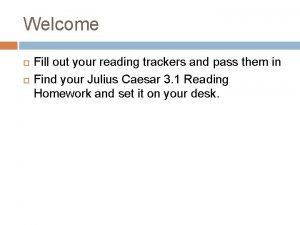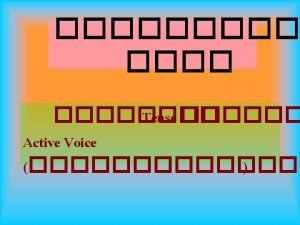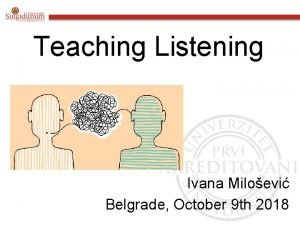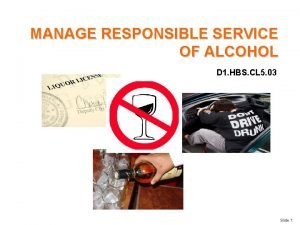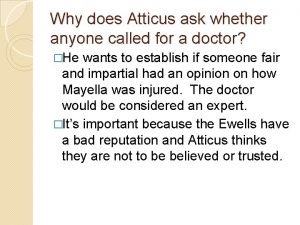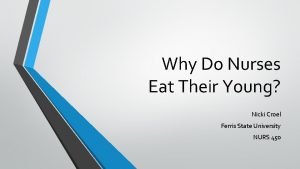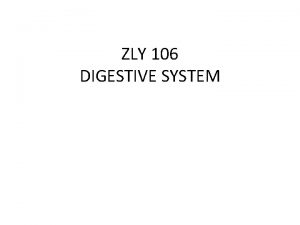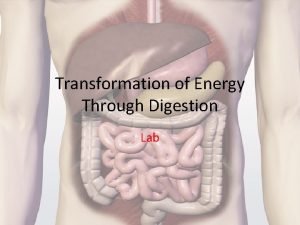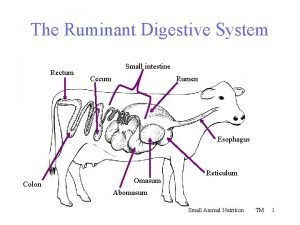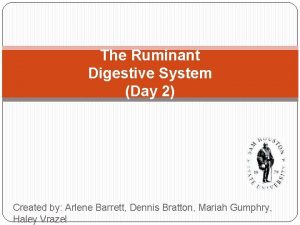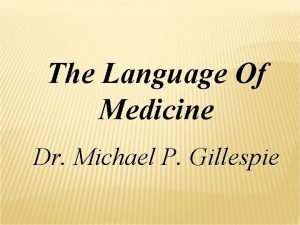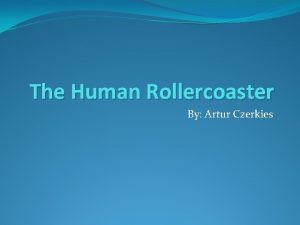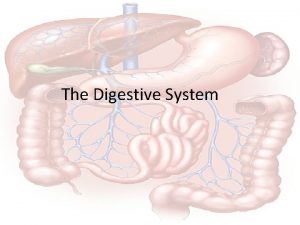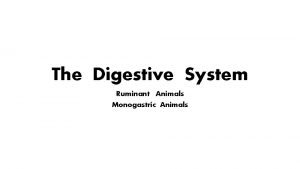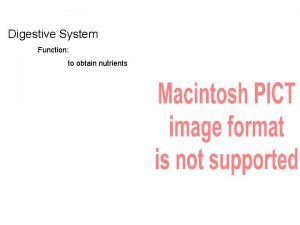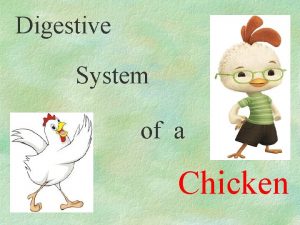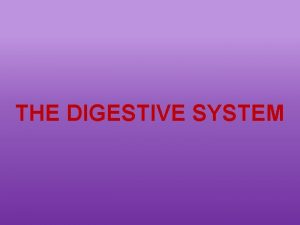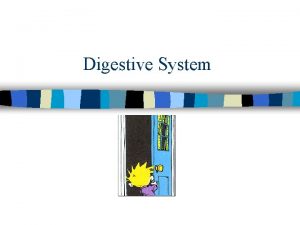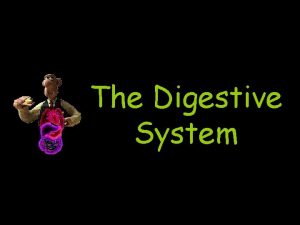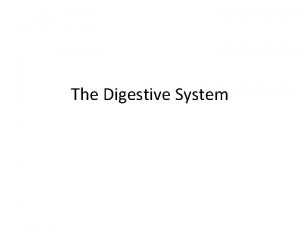Digestive System Why do we eat Nutrients serve





















- Slides: 21

Digestive System

Why do we eat? • Nutrients serve as fuel and building materials for our cells • Remember that the energy stored in food molecules is released to cells during cellular respiration • During cellular respiration energy stored in food is converted to ATP energy the cell can use.

Function • To break down food into nutrients • The nutrients are delivered to all the body cells to be used as energy for life processes

What is a nutrient? • A nutrient is a chemical substance in food • It is needed by the body for growth, energy and life processes • What are some examples of nutrients? ___________________

2 Types of Digestion: Mechanical vs. Chemical • Mechanical Digestion – is the physical break down (or movement) of food into smaller pieces using physical actions. • Examples: – Chewing – Mixing in your stomach

Chemical Digestion • Chemical Digestion – the chemical break down of food into smaller pieces. Chemicals called enzymes break down food into small molecules that the body can use. • Examples: – Saliva – Stomach acid

Digestive Tract: It all starts in the mouth! • Mechanical Digestion: What physically breaks food apart in the mouth? _____ • Chemical Digestion: What is in the mouth that helps with chemical digestion? ____ • Your tongue pushes food back and you swallow.

Cracker Taste Test • Place part of a cracker on your tongue. • Close your mouth and let the cracker melt in your mouth for a few minutes. • How does the taste of the cracker change? _______________________ What is happening? Your salivary glands release saliva into your mouth. Saliva is made of water, mucin and an enzyme called amylase. The amylase enzyme starts chemically breaking down starches into sugars right inside your mouth!

Digestive Tract continued…. • In the Pharynx (throat) a trap door called the epiglottis, closes over the windpipe when you swallow to prevent you from choking. • Esophagus – the tube that carries food to the stomach. • Food is moved by waves of smooth contractions known as peristalsis. http: //animations. 3 d 4 medical. com/Peristalsis-animation_AN 2441. html muscle

Digestive Tract continued… Stomach – Digestive organ that breaks down food. • Connects the esophagus to the small intestine. • Both Mechanical and Chemical Digestion happen here. • Mechanical –churning and mixing of food • Chemical - stomach acids and enzyme pepsin breaks down proteins into smaller molecules.

Digestive Tract continued… • Small Intestine – Organ where MOST DIGESTION takes place. About 23 ft. long, but has a “small” diameter of only 1 -2 inches. • Once food has been broken into small molecules, it sends nutrients to the bloodstream through a process called absorption.

Digestive Tract continued… • During absorption, molecules enter the circulatory system (blood) from the villi in the small intestine. • The circulatory system carries nutrients to all the body cells and to be used to create energy. DIGESTION STOPS HERE!!! • Wastes move on to the large intestine

Check for Understanding……. . List the pathway that food travels through the digestive tract. Mouth _______________________ 1. 2. Where do the useful molecules (nutrients) go after they leave the small intestine? ____________________________________________ 3. What happens to the waste that the body can’t use? Where does it go? ______________________

Digestive Tract continued…. . • Large Intestine – Organ that absorbs (soaks up) extra water out of waste. Is 5 ft. long, and has a “large” diameter of about 3 - 4 inches. • The remaining waste becomes feces (poop).

Digestive Tract continued…. • Rectum – Undigested food (feces) is collected here for about a day • The anus is an opening where solid wastes are eliminated.

Digestive Helpers: Help the small intestine with the process of chemical digestion, but food NEVER goes into these organs! 1. Pancreas: a. produces enzymes that break down carbohydrates, proteins and lipids (fats) b. makes insulin to regulate the sugar levels in the blood, 2. Liver: makes a chemical called bile that helps to absorb fats. 3. Gall Bladder: stores bile that is made in the liver.



Interpreting Diagrams: Use the chart and diagrams on the previous 2 slides to answer the following: 1) How many different chemical reactions can an enzyme speed up? 1, 2, thousands 2) In the first diagram, the enzyme is helping convert sucrose (table sugar) into _______ and ________. 3) What kind of p. H level does salivary amylase need to work best in? ________ 4) In which organ would you find the enzyme pepsin? ________ 5) What does the enzyme pepsin help break down? __________ 6) Which organ of the digestive tract has the most enzymes helping it? __________

Remember, your body is like a machine! It needs energy to keep on working!! http: //www. youtube. com/watch? v=w. LMRCga. AYIM

Body System Connections No body system can work alone. It is dependent on other systems to maintain regulation/homeostasis Describe a connection the digestive system has with the following systems: • Skeletal System? ____________ • Muscular System? ___________ • Circulatory System? __________ • Can you think of any other systems? _____________________
 The digestive system you are what you eat worksheet answers
The digestive system you are what you eat worksheet answers Pictures
Pictures Respiratory digestive and circulatory system
Respiratory digestive and circulatory system I would rather eat potatoes than to eat rice.
I would rather eat potatoes than to eat rice. I eat, you eat, he eats
I eat, you eat, he eats People buy me to eat
People buy me to eat Why is serving jugs of alcohol irresponsible
Why is serving jugs of alcohol irresponsible Nervous system and digestive system
Nervous system and digestive system Don't ask why why why
Don't ask why why why Who do dill and scout meet outside?
Who do dill and scout meet outside? Food chains food webs and energy pyramid worksheet
Food chains food webs and energy pyramid worksheet Why do nurses eat their young
Why do nurses eat their young Ruminant digestive system
Ruminant digestive system Monogastric system
Monogastric system Energy transformation in digestion
Energy transformation in digestion Define todays
Define todays Digestive system of ruminants
Digestive system of ruminants Ruminant stomach diagram
Ruminant stomach diagram Which term means “no sperm or semen are produced”?
Which term means “no sperm or semen are produced”? Digestive system roller coaster
Digestive system roller coaster What produces bile
What produces bile Monogastric animal
Monogastric animal



